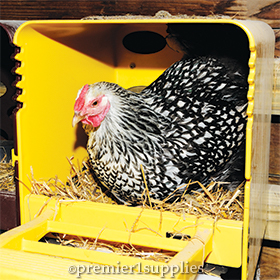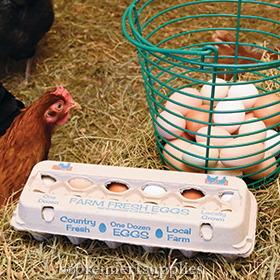| |
|
The “Egg Shed”
|
|
By Patricia Foreman author of City Chicks: Employing Chickens as Garden Helpers, Compost Creators, Bio-recyclers and Local Food Suppliers
|
| |
| |

|
| What is the most direct way to source eggs? Grow your own by raising a laying flock! Ventilated ChickBox™ (shown above) keeps hens warm in winter and cool in summer.
|
|
Know Your Egg Shed
I first heard of the term “egg shed” while chatting with Karl Hammer, owner of the Vermont Compost Company (VCC). We were standing on a hillside overlooking mountains of compost. These compost piles were made from food residues collected from about 49 institutions including the schools, restaurants, company cafeterias, and any other organization that produced enough food scraps to merit collecting. Vermont has a zero-waste policy, so instead of calling food leftovers “waste”, they call the biomass “residuals”.
What is unique about the Vermont Compost Company is that they employ about 1,200 free range chickens to help create their organic compost and potting soils. The chickens turn and aerate the fermenting piles, while keeping the insect and rodent populations down. The chickens glean food scraps off the road and other places to keep the operations tidy. They also grace the piles with their manure and feathers adding valuable nitrogen. The fermenting compost piles had no smells putrid of garbage—like landfills do. They smelled mostly of dark chocolate colored, musky humus in the making.
|
| |
|
The VCC’s 1,200 chickens work every day—and not even for chicken feed! They get all their food completely off the compost piles. The chickens combined efforts are worth about 4 tons of fuel-free, heavy equipment that work 365 days a year, rain, snow or shine, without any other inputs.
|
| |
|
Karl was explaining to me that his “clucking composters” would lay, on average, about 1,000 dozen eggs a month (12,000 organic eggs/year). Karl went on to explain that these eggs helped fulfill the Montpelier “egg shed”. The Vermont Compost Company could not be better located for their urban egg shed. The VCC’s address is 1996 Main Street, in Montpelier, the State capital of Vermont. VCC is on 5 very hilly acres within the city limits.
|
| |

|
| The morning’s harvest! The hens may squawk a little when you make a grab for their eggs, but the payoff is worth it.
|
|
How to define an egg shed?
Let’s look at the definition of watershed to give the egg shed concept more shape. A watershed is defined by the Environmental Protection Agency as: “The area of land where all of the water that is under it, or drains off of it, goes into the same place”. Based on the definition of a watershed, an egg shed could be defined as: the eggs produced within a certain distance that go to a specific place. That place could be your kitchen, schools, farmers’ markets, restaurants, etc.
The concept of egg sheds become real once we can calculate the average number of eggs humans eat within a specific area, and how many hens are needed to produce those eggs. Let’s refine our definition of eggs shed as; “An egg shed is the number of eggs a person, household, group, or community, consumes that are produced within a specific distance, within a period of time—usually a year.”
|
| |
Here’s How to Calculate Your Egg Shed
Now that we’ve defined what an egg shed is, we can establish a formula to make it practical. The US Poultry and Egg Association estimates that the average per capita egg consumption in 2012 was 249 eggs/person. For our egg shed formula, let’s round that average up to 250 eggs consumed/person.
|
| |
|
The American Egg Board estimates the average commercial laying hen produces about 265 eggs/year. Heritage laying hens lay fewer eggs from about 200 to 270 eggs depending on the breed. For our egg shed formula, we’ll assume an average hen lays 250 eggs/year. That makes the math super simple.That works out nicely so that 1 laying hen (in full production) will produce enough eggs for 1 person each year: 1 hen for 1 person in the egg shed.
|
| |
Now let’s calculate how many eggs an egg shed requires. Let’s use a population of 30,000. How many eggs would a population of 30,000 consume each year?
Here is the formula:
Population * 250 eggs consumed per person/year = Egg shed requirement
|
| |
Just plug in the numbers:
30,000 (population) * 250 (egg consumption per year) = 7,500,000 eggs!
Yolks! Seven and a half million eggs for 30,000 people! That seems like a lot to produce!
|
| |
|
But let’s run the model again with different flock sizes. What if just 10% of the population kept 10 hens in family flocks. For our population of 30,000, 10% would be 3,000 family flocks. Egg shed = 3,000 family flocks (10 hens each flock) producing 250 eggs/year = 7,500,000 eggs. Yolks galore! That meets the egg shed!
|
| |
|
What if chickens are not legal in your community? Then you could support local farmers.
|
- If 1% of the population—300 poultry producers kept 100 hens each laying 250 eggs/year = 7,500,000 eggs = the egg shed.
- If 0.5% of the population—150 poultry producers kept 200 hens each laying 250 eggs/year = 7,500,000 eggs = the egg shed.
- If 0.2% of the population—60 poultry producers kept 500 hens each laying 250 eggs/year = 7,500,000 eggs = the egg shed.
|
Of course, in chicken-friendly, local-food-supportive, green, low-carbon-footprint communities—there are backyard flocks and small family farms producing eggs. The take-away message is that egg shed needs for a family, or a community, are relatively easy to meet. That means a household or a community can somewhat easily be protein self-sufficient. That’s a WOW!
May the flock be with you!
Pat Foreman
|
| |
References
1. U.S. Poultry & Egg Association
2. American Egg Board
|
| |
|
|
| |
|
Patricia Foreman is the author of City Chicks. She is the co-author of Chicken Tractor and Day Range Poultry. Pat is the developer of the Chickens and You Training Series, leading to the Master Backyard Chicken Keeper Certification. She is a popular speaker at the Mother Earth Fairs, Monticello’s Heritage Harvest Festivals, Nourishing Traditions Conferences and many others.
|
|
* The views and opinions of the authors who have submitted articles to Premier1Supplies.com belong to them alone and do not necessarily reflect the views or opinions of Premier1Supplies.com, its staff or owners.
|
|
|
| |
|
|

|
Questions? Call Us.
800-282-6631
Local: 319-653-7622
Fax: 800-346-7992 or 319-653-6304
|
|
|
Business Hours:
Monday - Friday: 7 am - 5:30 pm CT
(January - December)
Saturday: 8am - 12 noon CT (March - September) and Closed (October - February)
Sunday: Closed
© Copyright 2016 Premier1Supplies
2031 300th Street, Washington, Iowa 52353
Contact Us
|
|
|
|
|
|
|
